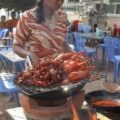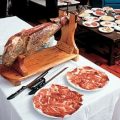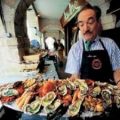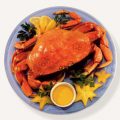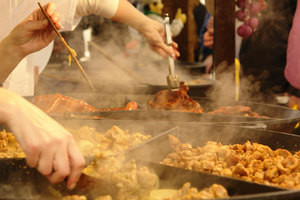 Dishes of Chinese cuisineThe Chinese cuisine is divided into"Fan" and "tsai" are two inseparable and opposite parts, complementing each other and class, and antagonistic. Fan is about the same as bread for us, that is, the basic food that makes it possible to live. And although the word "fan" means rice, it is customary to call them noodles, and any flour and grain products. Cai - all the rest is edible, which was in the hands of the cook: vegetables, meat, poultry, seafood, fruit, nuts. Mao Tse-tung once said a slogan, radically different from the food program of King Henry IV, who dreamed that every peasant family in France at least once a week could cook a chicken for lunch. The words spoken by the Great Helmsman sounded laconic and tougher: "Iron cup of rice." What does it mean? Of course, it's not that fine Chinese porcelain vans should be replaced by metal, but that every Chinese citizen must "iron" consume a cup of rice a day, in other words, do not starve. As the welfare grows, the king can be added to the fan, from the most common type, Chinese cabbage, to all known, but few people tried sunhuadan - "rotten eggs." Ideally, the Chinese diet should be balanced in such a way that the fan and tsai complement each other friend in the image of the female and the male began to yin and yang. And if the proportions of cereals, vegetables and animal protein are harmoniously correlated in nutrition, then, according to Chinese concepts, there will be a correct tsan, that is, a table.
Dishes of Chinese cuisineThe Chinese cuisine is divided into"Fan" and "tsai" are two inseparable and opposite parts, complementing each other and class, and antagonistic. Fan is about the same as bread for us, that is, the basic food that makes it possible to live. And although the word "fan" means rice, it is customary to call them noodles, and any flour and grain products. Cai - all the rest is edible, which was in the hands of the cook: vegetables, meat, poultry, seafood, fruit, nuts. Mao Tse-tung once said a slogan, radically different from the food program of King Henry IV, who dreamed that every peasant family in France at least once a week could cook a chicken for lunch. The words spoken by the Great Helmsman sounded laconic and tougher: "Iron cup of rice." What does it mean? Of course, it's not that fine Chinese porcelain vans should be replaced by metal, but that every Chinese citizen must "iron" consume a cup of rice a day, in other words, do not starve. As the welfare grows, the king can be added to the fan, from the most common type, Chinese cabbage, to all known, but few people tried sunhuadan - "rotten eggs." Ideally, the Chinese diet should be balanced in such a way that the fan and tsai complement each other friend in the image of the female and the male began to yin and yang. And if the proportions of cereals, vegetables and animal protein are harmoniously correlated in nutrition, then, according to Chinese concepts, there will be a correct tsan, that is, a table. The cult of freshnessFrom the European point of view, the rulesof a traditional Chinese meal are turned inside out. This is very similar to how the Chinese wrote texts from right to left and top to bottom before the writing reform. They also eat the other way around. Until now. The feast begins with tea and ends with... soup. At first, this seems wild: after all, we are used to finishing a hearty lunch with tea and are absolutely sure that we are doing the right thing. Although, from the point of view of modern nutritionists, such a sequence of dishes is quite consistent with the formula for healthy and proper nutrition. A cup of tea before lunch in Chinese tradition is something like an aperitif. And therefore, first a "warm-up", then snacks, then a hot dish and only at the end - soup. It is believed that the "hot spot", which is placed in the epilogue, is needed in order to quickly digest and assimilate what has been eaten. After drinking a bowl of such soup, you feel that all the dishes have "settled into place". Another value of Chinese cuisine is that no dish is prepared the day before and reheated the next day. Every day, products are bought, quickly cooked, eaten, and the next day, everything is repeated from the beginning. It was the Chinese who invented the method of cooking that is called "stir-fry" in the West. Vitamins in food prepared in this way do not have time to "die", which enhances its nutritional properties.
The cult of freshnessFrom the European point of view, the rulesof a traditional Chinese meal are turned inside out. This is very similar to how the Chinese wrote texts from right to left and top to bottom before the writing reform. They also eat the other way around. Until now. The feast begins with tea and ends with... soup. At first, this seems wild: after all, we are used to finishing a hearty lunch with tea and are absolutely sure that we are doing the right thing. Although, from the point of view of modern nutritionists, such a sequence of dishes is quite consistent with the formula for healthy and proper nutrition. A cup of tea before lunch in Chinese tradition is something like an aperitif. And therefore, first a "warm-up", then snacks, then a hot dish and only at the end - soup. It is believed that the "hot spot", which is placed in the epilogue, is needed in order to quickly digest and assimilate what has been eaten. After drinking a bowl of such soup, you feel that all the dishes have "settled into place". Another value of Chinese cuisine is that no dish is prepared the day before and reheated the next day. Every day, products are bought, quickly cooked, eaten, and the next day, everything is repeated from the beginning. It was the Chinese who invented the method of cooking that is called "stir-fry" in the West. Vitamins in food prepared in this way do not have time to "die", which enhances its nutritional properties. Although it should be noted that the orientation of the Chineseкухни на свежесть не отменяет наличия в ней продуктовых заготовок. Чтобы пережить зиму, китайцы точно так же, как мы, высушивают, засаливают, засахаривают или маринуют овощи и растения. Свежесть свежестью, а скудость меню эти заготовки скрашивают. Голод не тетка, и некоторыми принципами вполне можно поступиться. Со скоростью стукаЛюбое блюдо китайской кухни пригодно к поеданию палочками-куйацзы, и, наверно, никто не ответит на вопрос, что именно китайцы придумали раньше: резать еду на мелкие, ухватываемые куйацзы кусочки, или выстругивать из дерева палочки для удобной транспортировки с тарелки в рот «эргономичных» кусочков. Куайцзы находят при археологических раскопках, и это неудивительно: жители долин Хуанхэ и Янцзы пользуются ими более 3 тысяч лет. Чжу, так в древности называли палочки, упомянуты в трактате «Ли-цзи» («Книге ритуала»), а отец китайской историографии Сыма Цянь в своем классическом труде «Ши-цзи» («Исторические записки») уточнял, что последний правитель династии Шан (ок. 1100 года до н. э.) пользовался палочками из слоновой кости. Лакированные палочки времен династии Западная Хань (206 год до н. э. — 24 год н. э.) обнаружили при раскопках в местечке Маваньдуй в провинции Хэнань, а во времена династии Тан (618—907 годы) стали популярны золотые и серебряные палочки. Последние, по легенде, служили своеобразным индикатором — по ним проверяли, отравлена пища или нет. Первый иероглиф «куай» в куайцзы образован от иероглифа «быстрый» добавлением сверху иероглифа «бамбук», что показывает, из какого материала традиционно делаются палочки, кроме того, сходная этимология у слова «кусочек», который и читается похоже — «куай». Вот и получается, что палочки — приспособление, предназначенное для ускорения поглощения кусочков пищи. Традиционные куйацзы бывают пяти видов: деревянные, металлические, костяные, каменные и из комбинаций этих материалов. Сейчас в Китае популярнее всего палочки из прочной пластмассы, имитирующей кость, хотя предпочтение отдается палочкам из железного дерева: они поистине бессмертны, ими могут есть несколько поколений семьи, а вот «общепит» любит одноразовые — из недорогой древесины и бамбуковые куайцзы. Есть палочками несложно. Китайская экспансия, о которой так любят говорить политологи, в первую очередь коснулась безобидных вещей — весь мир с удовольствием забегает в китайские ресторанчики, заказывает домой «take-out» и неизбежно ест палочками. Чтобы отведать фань и цай палочками, надо жестко упереть одну палочку в сочленение большого и указательного пальцев «рабочей» руки, а вторую взять той же рукой так, как вы держите, скажем, карандаш. Потренируйтесь на мелких предметах — щепках, листках бумаги, крекерах… Когда вам удастся метко и небрежно постукивать кончиком одной палочки о другую, вы достигли совершенства. Правда, замечена одна закономерность: как только начинаешь хвастаться, как хорошо ты владеешь куайцзы, коварный кусочек еды или пельмень немедленно выскальзывает и падает в блюдечко с соевым соусом. Китайская еда не терпит суеты. Часто спрашивают: как можно есть палочками рис? Никаких чудес: китайский рис клеек, а не рассыпчат. Поэтому взять палочками из пиалы комочек риса несложно. Едят с помощью куайцзы и суп. Сначала ими выуживают твердые ингредиенты, а затем оставшуюся жидкость вычерпывают из пиалы-вань характерной фарфоровой ложечкой с короткой ручкой.
Although it should be noted that the orientation of the Chineseкухни на свежесть не отменяет наличия в ней продуктовых заготовок. Чтобы пережить зиму, китайцы точно так же, как мы, высушивают, засаливают, засахаривают или маринуют овощи и растения. Свежесть свежестью, а скудость меню эти заготовки скрашивают. Голод не тетка, и некоторыми принципами вполне можно поступиться. Со скоростью стукаЛюбое блюдо китайской кухни пригодно к поеданию палочками-куйацзы, и, наверно, никто не ответит на вопрос, что именно китайцы придумали раньше: резать еду на мелкие, ухватываемые куйацзы кусочки, или выстругивать из дерева палочки для удобной транспортировки с тарелки в рот «эргономичных» кусочков. Куайцзы находят при археологических раскопках, и это неудивительно: жители долин Хуанхэ и Янцзы пользуются ими более 3 тысяч лет. Чжу, так в древности называли палочки, упомянуты в трактате «Ли-цзи» («Книге ритуала»), а отец китайской историографии Сыма Цянь в своем классическом труде «Ши-цзи» («Исторические записки») уточнял, что последний правитель династии Шан (ок. 1100 года до н. э.) пользовался палочками из слоновой кости. Лакированные палочки времен династии Западная Хань (206 год до н. э. — 24 год н. э.) обнаружили при раскопках в местечке Маваньдуй в провинции Хэнань, а во времена династии Тан (618—907 годы) стали популярны золотые и серебряные палочки. Последние, по легенде, служили своеобразным индикатором — по ним проверяли, отравлена пища или нет. Первый иероглиф «куай» в куайцзы образован от иероглифа «быстрый» добавлением сверху иероглифа «бамбук», что показывает, из какого материала традиционно делаются палочки, кроме того, сходная этимология у слова «кусочек», который и читается похоже — «куай». Вот и получается, что палочки — приспособление, предназначенное для ускорения поглощения кусочков пищи. Традиционные куйацзы бывают пяти видов: деревянные, металлические, костяные, каменные и из комбинаций этих материалов. Сейчас в Китае популярнее всего палочки из прочной пластмассы, имитирующей кость, хотя предпочтение отдается палочкам из железного дерева: они поистине бессмертны, ими могут есть несколько поколений семьи, а вот «общепит» любит одноразовые — из недорогой древесины и бамбуковые куайцзы. Есть палочками несложно. Китайская экспансия, о которой так любят говорить политологи, в первую очередь коснулась безобидных вещей — весь мир с удовольствием забегает в китайские ресторанчики, заказывает домой «take-out» и неизбежно ест палочками. Чтобы отведать фань и цай палочками, надо жестко упереть одну палочку в сочленение большого и указательного пальцев «рабочей» руки, а вторую взять той же рукой так, как вы держите, скажем, карандаш. Потренируйтесь на мелких предметах — щепках, листках бумаги, крекерах… Когда вам удастся метко и небрежно постукивать кончиком одной палочки о другую, вы достигли совершенства. Правда, замечена одна закономерность: как только начинаешь хвастаться, как хорошо ты владеешь куайцзы, коварный кусочек еды или пельмень немедленно выскальзывает и падает в блюдечко с соевым соусом. Китайская еда не терпит суеты. Часто спрашивают: как можно есть палочками рис? Никаких чудес: китайский рис клеек, а не рассыпчат. Поэтому взять палочками из пиалы комочек риса несложно. Едят с помощью куайцзы и суп. Сначала ими выуживают твердые ингредиенты, а затем оставшуюся жидкость вычерпывают из пиалы-вань характерной фарфоровой ложечкой с короткой ручкой. 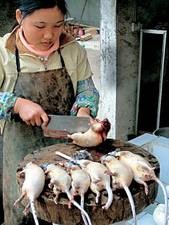 Sociable natureIt is not customary for the Chinese to eat inalone. A company that has come to a restaurant or eatery (in traditional China, naturally, there were no cafes - the culture here is tea, not coffee) orders a lot of dishes. According to the classic ordering scheme, the number of main courses (excluding soups and cold appetizers) corresponds to the number of diners + 1 (from the host). Table etiquette, which is no less important than all other Chinese ceremonies, dictates that the most honored guest should make the first choice. Being aware of the traditions, he will order something meaty, say, pork "gu lao zhou". The next participant in rank will choose a poultry dish (let's say, imperial chicken or lemon chicken, so popular in America, or steamed duck Guangdong style). The third - fish ("pine cones" from carp or pike perch in sweet and sour sauce). The main backbone of the meal has been outlined. The rest can be satisfied with ordering all sorts of small things - seafood, vegetables, candied fruits and so on. The optimal number of participants in such a feast is four, better eight: it is offensive to try less than four dishes, and more than eight is difficult. The brought dishes are placed in the center of the round table on a special rotating plate, which allows each participant of the meal to take any piece from the dish with chopsticks and put it on his plate. Rice, soy, boiling water Chinese ceremonies and hospitality are inseparable. A guest who has come even to a poor man's hut cannot help but be treated. And if there is no tea in the house, he will be offered simple boiling water - kaishui. In the end, any act of friendliness throughout the world comes down to giving a traveler water. The inhabitants of the Middle Kingdom do not know the word "side dish". The basis of a Chinese meal is a cup of rice and a bowl of boiling water. If there is any cai with fan, it is put on top of the rice. Perhaps, Chinese food cannot exist without one more component - soy sauce, as everywhere in the Far East. Moreover, this sauce is used for cooking and for seasoning ready meals. Soy sauce is a supplier of salt. All this is traditional Chinese food.
Sociable natureIt is not customary for the Chinese to eat inalone. A company that has come to a restaurant or eatery (in traditional China, naturally, there were no cafes - the culture here is tea, not coffee) orders a lot of dishes. According to the classic ordering scheme, the number of main courses (excluding soups and cold appetizers) corresponds to the number of diners + 1 (from the host). Table etiquette, which is no less important than all other Chinese ceremonies, dictates that the most honored guest should make the first choice. Being aware of the traditions, he will order something meaty, say, pork "gu lao zhou". The next participant in rank will choose a poultry dish (let's say, imperial chicken or lemon chicken, so popular in America, or steamed duck Guangdong style). The third - fish ("pine cones" from carp or pike perch in sweet and sour sauce). The main backbone of the meal has been outlined. The rest can be satisfied with ordering all sorts of small things - seafood, vegetables, candied fruits and so on. The optimal number of participants in such a feast is four, better eight: it is offensive to try less than four dishes, and more than eight is difficult. The brought dishes are placed in the center of the round table on a special rotating plate, which allows each participant of the meal to take any piece from the dish with chopsticks and put it on his plate. Rice, soy, boiling water Chinese ceremonies and hospitality are inseparable. A guest who has come even to a poor man's hut cannot help but be treated. And if there is no tea in the house, he will be offered simple boiling water - kaishui. In the end, any act of friendliness throughout the world comes down to giving a traveler water. The inhabitants of the Middle Kingdom do not know the word "side dish". The basis of a Chinese meal is a cup of rice and a bowl of boiling water. If there is any cai with fan, it is put on top of the rice. Perhaps, Chinese food cannot exist without one more component - soy sauce, as everywhere in the Far East. Moreover, this sauce is used for cooking and for seasoning ready meals. Soy sauce is a supplier of salt. All this is traditional Chinese food.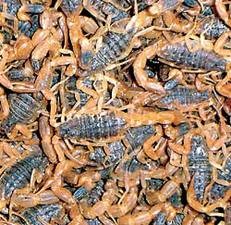 "Xiaochi" for every tasteFor the busy or the leisurelyчеловека проблемы, где бы поесть в Пекине, просто не существует. При этом в Китае можно насытиться, даже не заходя в «застенные» точки общепита. Уличные торговцы предлагают разные виды «сяочи» — «маленькой еды-перекуса». Начнем с печенного в бочке сладкого или ямса — прекрасно усваиваемой пищи, которая благодаря содержащемуся в клубнях крахмалу заправляет едока на хорошие полдня, сочетая нежность печеного картофеля и деликатную сладость конфеты «Му-Му». А если захотелось мяса? Пожалуйста! Китайские мусульмане держат шашлычный бизнес (мясо, жаренное на шпильках, называется «каожоучуань»). Кусочки будут маленькими, шпильки — тоненькими, мясо на них самое разное. Баранина, говядина, крошечные перепелки… Захотелось сладкого? Вам тут же предложат палочки с празднично выглядящими крупными алыми ягодами боярышника или любыми другими засахаренными фруктами, которыми особенно славится главная пекинская торговая улица Ванфуцзин. Нет проблем и с мучным. Продавцы цзяньбин пекут блины тут же, прямо на уличной жаровне. Такой креп с яйцом и острым соусом съесть можно только один — уж больно велик и питателен. Южнее,в Сиани, на улице можно найти даже пельмени, которые вообще-то едят в помещении. Правда, чем южнее мы будем продвигаться, тем меньше на улицах будет мяса, поэтому можно нарваться на пельмени с одной зеленью. Есть и более экзотические вещи: например, Ханчжоу славится запеченными улитками, гигантскими личинками тутового шелкопряда (тоже на палочке), лапками кур и копытцами свиней, утиными головами прямо с клювами… Найдется все, хватило бы мужества это попробовать. Чудо-самоварНастоящее чудо национальной кухни — «китайский самовар», «хого». На самом деле это блюдо пришло в Поднебесную из Монголии вместе с завоевателями-чингизидами. Иностранцы недаром называют его «монгольским», а иногда и «мусульманским» самоваром, ибо он популярен у мусульман-дунган. Хого наглядно демонстрирует адаптивность китайской пищевой культуры, впитывающей и усваивающей любые пригодные продукты и способы их приготовления. Если изначально в котле-«самоваре» варили баранину, то китайцы на этом не остановились. Мы уже обмолвились: истинный вкус продукта для местного повара — не императив. Особенно отчетливо понимаешь это, участвуя в трапезе, включающей хого. В большой железной кастрюле на ножках, стоящей перед едоками, варится все, что есть съестного в доме. Наверно, философия такого рода блюд знакома большинству культур, и в народе подобные сборные солянки носят обобщенное название «ирландское рагу», но китайский самовар — вещь иная, хотя может считаться чем-то вроде фондю. Внутри котла закипает вода. Затем вам начинают подносить ингредиенты для загрузки внутрь: например, трехдневных мышат. Повар зажимает новорожденного грызуна в кулак и бьет деревянным молоточком по носу. Остается взять оглушенных, но живых мышат за хвост, опалить над свечой (блюдо так и называется «Мыши на свечах») и на полминуты окунуть в кипяток. Потом мышонка макают в соус и съедают целиком. Оставшийся сырым мышиный хвостик суеверные китайцы перебрасывают через левое плечо. Но все же более традиционно подают тонко нарезанное мясо (разное), длинную китайскую капусту (она продается у нас под названием «китайский салат»), креветки, лапшу (в том числе «стеклянную» рисовую фунчозу), стружку овощей — морковь, бобовые (соевые) побеги, китайские грибы — дунгу (известные на Западе под японским названием ситакэ), черные грибы-муэр («древесное ухо»), в общем, все, что не скрылось. Ингредиенты следует палочками запускать в воду (понятно, что после первого же погружения в котел животных ингредиентов получается именно бульон), а потом, через очень непродолжительное время, когда они разок-другой прокипят, быстренько выхватывать их из бульона и ополаскивать в соевом соусе. Изумительная вещь! Помимо прочего, очень сплачивает пирующих и оживляет атмосферу. Самовар — квинтэссенция погони китайцев за свежестью приготавливаемого продукта. Подвергать продукты тепловой обработке меньше и интенсивнее, чем в нем, не представляется возможным.
"Xiaochi" for every tasteFor the busy or the leisurelyчеловека проблемы, где бы поесть в Пекине, просто не существует. При этом в Китае можно насытиться, даже не заходя в «застенные» точки общепита. Уличные торговцы предлагают разные виды «сяочи» — «маленькой еды-перекуса». Начнем с печенного в бочке сладкого или ямса — прекрасно усваиваемой пищи, которая благодаря содержащемуся в клубнях крахмалу заправляет едока на хорошие полдня, сочетая нежность печеного картофеля и деликатную сладость конфеты «Му-Му». А если захотелось мяса? Пожалуйста! Китайские мусульмане держат шашлычный бизнес (мясо, жаренное на шпильках, называется «каожоучуань»). Кусочки будут маленькими, шпильки — тоненькими, мясо на них самое разное. Баранина, говядина, крошечные перепелки… Захотелось сладкого? Вам тут же предложат палочки с празднично выглядящими крупными алыми ягодами боярышника или любыми другими засахаренными фруктами, которыми особенно славится главная пекинская торговая улица Ванфуцзин. Нет проблем и с мучным. Продавцы цзяньбин пекут блины тут же, прямо на уличной жаровне. Такой креп с яйцом и острым соусом съесть можно только один — уж больно велик и питателен. Южнее,в Сиани, на улице можно найти даже пельмени, которые вообще-то едят в помещении. Правда, чем южнее мы будем продвигаться, тем меньше на улицах будет мяса, поэтому можно нарваться на пельмени с одной зеленью. Есть и более экзотические вещи: например, Ханчжоу славится запеченными улитками, гигантскими личинками тутового шелкопряда (тоже на палочке), лапками кур и копытцами свиней, утиными головами прямо с клювами… Найдется все, хватило бы мужества это попробовать. Чудо-самоварНастоящее чудо национальной кухни — «китайский самовар», «хого». На самом деле это блюдо пришло в Поднебесную из Монголии вместе с завоевателями-чингизидами. Иностранцы недаром называют его «монгольским», а иногда и «мусульманским» самоваром, ибо он популярен у мусульман-дунган. Хого наглядно демонстрирует адаптивность китайской пищевой культуры, впитывающей и усваивающей любые пригодные продукты и способы их приготовления. Если изначально в котле-«самоваре» варили баранину, то китайцы на этом не остановились. Мы уже обмолвились: истинный вкус продукта для местного повара — не императив. Особенно отчетливо понимаешь это, участвуя в трапезе, включающей хого. В большой железной кастрюле на ножках, стоящей перед едоками, варится все, что есть съестного в доме. Наверно, философия такого рода блюд знакома большинству культур, и в народе подобные сборные солянки носят обобщенное название «ирландское рагу», но китайский самовар — вещь иная, хотя может считаться чем-то вроде фондю. Внутри котла закипает вода. Затем вам начинают подносить ингредиенты для загрузки внутрь: например, трехдневных мышат. Повар зажимает новорожденного грызуна в кулак и бьет деревянным молоточком по носу. Остается взять оглушенных, но живых мышат за хвост, опалить над свечой (блюдо так и называется «Мыши на свечах») и на полминуты окунуть в кипяток. Потом мышонка макают в соус и съедают целиком. Оставшийся сырым мышиный хвостик суеверные китайцы перебрасывают через левое плечо. Но все же более традиционно подают тонко нарезанное мясо (разное), длинную китайскую капусту (она продается у нас под названием «китайский салат»), креветки, лапшу (в том числе «стеклянную» рисовую фунчозу), стружку овощей — морковь, бобовые (соевые) побеги, китайские грибы — дунгу (известные на Западе под японским названием ситакэ), черные грибы-муэр («древесное ухо»), в общем, все, что не скрылось. Ингредиенты следует палочками запускать в воду (понятно, что после первого же погружения в котел животных ингредиентов получается именно бульон), а потом, через очень непродолжительное время, когда они разок-другой прокипят, быстренько выхватывать их из бульона и ополаскивать в соевом соусе. Изумительная вещь! Помимо прочего, очень сплачивает пирующих и оживляет атмосферу. Самовар — квинтэссенция погони китайцев за свежестью приготавливаемого продукта. Подвергать продукты тепловой обработке меньше и интенсивнее, чем в нем, не представляется возможным. 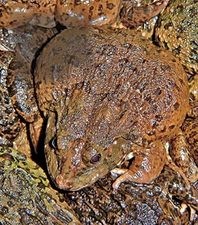 Everything except the moonFor all its “feng shui”The Chinese culture has no sacred awe of nature when it comes to survival and nutrition. As the Chinese themselves say, a good cook will cook everything except the moon, everything that has four legs except a chair, and everything that has no legs at all, too. No sentimentality about animals: here, cute chubby puppies are sold not as pets, but for meat. And no one will bashfully avert their eyes. In the south, you will be treated to a dish of cat and cobra, which is called "The fight of the dragon and the tiger." The Chinese, tolerant of physical pain, if necessary, do not hesitate to inflict it on others. What kind of nerves do you need to have to remain calm when you see a man squatting in front of a live chicken and melancholically plucking its feathers?.. “Plucking a bird, especially a duck, is quite a difficult task,” the Zhogolevs, the authors of one of the first Chinese cookbooks in Russian, share their secret with us. “If you give the bird a dessert spoon of alcohol or vinegar to drink 10-20 minutes before slaughtering it, it will be much easier to remove the feathers.” It seems that the man I met was unfamiliar with these subtleties of the culinary art. The tragic fate of the Peking duckA dish that I have never been able to taste in its true Chinese splendor is the famous “beijing kaoya.” This dish entered the national cuisine after the Xinhai Revolution, when China ceased to be imperial and the people were able to join the most accessible aspects of aristocratic life. Everyone knows that ducks are rubbed with powdered sugar for color, the bird is boiled from the inside (water is poured inside), and baked from the outside (the duck hangs on a hook in a special oven), there are several "bringings" of slices of skin and duck meat, it is eaten with cucumber straws, leek shavings, in plum sauce, wrapped in a special thin pancake, and at the end of the duck meal it is supposed to be washed down with broth cooked from the bones left over from the bird. Not everyone, however, knows that a duck destined to become a delicacy is ideally tied to two pegs or put in a tight cage, not given water to drink and fed abundantly with oversalted food. The duck is roasted on peach wood, specially curved so that the bird can be placed in the center for even roasting. The most famous duck restaurant in Beijing is Quanjude, also on Wangfujing. However, each of the specialty restaurants has its own duck recipe, and the duck cook is never allowed to leave the establishment because he is closely related to the owner by clan ties.
Everything except the moonFor all its “feng shui”The Chinese culture has no sacred awe of nature when it comes to survival and nutrition. As the Chinese themselves say, a good cook will cook everything except the moon, everything that has four legs except a chair, and everything that has no legs at all, too. No sentimentality about animals: here, cute chubby puppies are sold not as pets, but for meat. And no one will bashfully avert their eyes. In the south, you will be treated to a dish of cat and cobra, which is called "The fight of the dragon and the tiger." The Chinese, tolerant of physical pain, if necessary, do not hesitate to inflict it on others. What kind of nerves do you need to have to remain calm when you see a man squatting in front of a live chicken and melancholically plucking its feathers?.. “Plucking a bird, especially a duck, is quite a difficult task,” the Zhogolevs, the authors of one of the first Chinese cookbooks in Russian, share their secret with us. “If you give the bird a dessert spoon of alcohol or vinegar to drink 10-20 minutes before slaughtering it, it will be much easier to remove the feathers.” It seems that the man I met was unfamiliar with these subtleties of the culinary art. The tragic fate of the Peking duckA dish that I have never been able to taste in its true Chinese splendor is the famous “beijing kaoya.” This dish entered the national cuisine after the Xinhai Revolution, when China ceased to be imperial and the people were able to join the most accessible aspects of aristocratic life. Everyone knows that ducks are rubbed with powdered sugar for color, the bird is boiled from the inside (water is poured inside), and baked from the outside (the duck hangs on a hook in a special oven), there are several "bringings" of slices of skin and duck meat, it is eaten with cucumber straws, leek shavings, in plum sauce, wrapped in a special thin pancake, and at the end of the duck meal it is supposed to be washed down with broth cooked from the bones left over from the bird. Not everyone, however, knows that a duck destined to become a delicacy is ideally tied to two pegs or put in a tight cage, not given water to drink and fed abundantly with oversalted food. The duck is roasted on peach wood, specially curved so that the bird can be placed in the center for even roasting. The most famous duck restaurant in Beijing is Quanjude, also on Wangfujing. However, each of the specialty restaurants has its own duck recipe, and the duck cook is never allowed to leave the establishment because he is closely related to the owner by clan ties.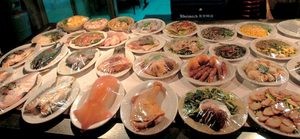 Chinese cuisine in exileWidely spreadthe opinion that authentic Chinese dishes can only be tasted in China, Southeast Asia and the Far East. This is both true and untrue. The Chinese themselves believe that authentic fan and cai can be made anywhere in the world, if only you have a wok, a sharp knife, a cutting board and “high heat”. In fact, the main characteristics of Chinese food - small pieces of cai and quick cooking - do not change depending on the geographic location and nationality of the person cutting it. Anyone who wants to play a Chinese chef can buy soy or even plum sauce, sesame oil, star anise, ginger, galangal (galangal in Russia), fennel, leeks, egg or rice noodles, petals of dumpling dough - even sea cucumbers! It is even easier to go to Chinatown. There you can buy “native” Chinese products, eat a couple dozen real jiaozi dumplings, steamed and served on a bamboo net, take home frozen durian and smoked duck, feeling like you are in a real little China for an hour or two. After all, Chinatowns are built by the Huaqiao Chinese not for the residents of San Francisco or Toronto, but first of all for themselves. And yet you can’t fool your tongue and palate: Chinese food outside the Great Wall does not quite taste the same. National cuisine, losing touch with its native land, flexibly adapts to local tastes. Shades become rougher, sweet and sour sauce is too sour or too sweet, vegetables are tough, pieces are too big, portions are too large. This difference is especially noticeable to those who have been to the Celestial Empire. Describing food in words is like talking about singing. It's better to hear singing once, food - at least once. Where to try it? Of course, in China.
Chinese cuisine in exileWidely spreadthe opinion that authentic Chinese dishes can only be tasted in China, Southeast Asia and the Far East. This is both true and untrue. The Chinese themselves believe that authentic fan and cai can be made anywhere in the world, if only you have a wok, a sharp knife, a cutting board and “high heat”. In fact, the main characteristics of Chinese food - small pieces of cai and quick cooking - do not change depending on the geographic location and nationality of the person cutting it. Anyone who wants to play a Chinese chef can buy soy or even plum sauce, sesame oil, star anise, ginger, galangal (galangal in Russia), fennel, leeks, egg or rice noodles, petals of dumpling dough - even sea cucumbers! It is even easier to go to Chinatown. There you can buy “native” Chinese products, eat a couple dozen real jiaozi dumplings, steamed and served on a bamboo net, take home frozen durian and smoked duck, feeling like you are in a real little China for an hour or two. After all, Chinatowns are built by the Huaqiao Chinese not for the residents of San Francisco or Toronto, but first of all for themselves. And yet you can’t fool your tongue and palate: Chinese food outside the Great Wall does not quite taste the same. National cuisine, losing touch with its native land, flexibly adapts to local tastes. Shades become rougher, sweet and sour sauce is too sour or too sweet, vegetables are tough, pieces are too big, portions are too large. This difference is especially noticeable to those who have been to the Celestial Empire. Describing food in words is like talking about singing. It's better to hear singing once, food - at least once. Where to try it? Of course, in China.

Making Money with Desserts: Success Stories
Evgeniya Polischuk (Fedutinova) instagram:@evgeniyafedutinovavk.com/janeshomebaking– It all started with baking for family and friends. Gradually, I started posting photos of my baked goods on Instagram – and orders started coming in. I made my first custom-made cake on October 13, 2014, and a little earlier I started making macaroons and cupcakes. You could say that the business “found me”, I am very […]

Soups are cold recipes with photos
Cold cucumber soup with yogurt and lemonsorbet from the chef of the restaurant La Taverna Alexander Zhurkin Photo: Getty Images Ingredients: Plain yoghurt – 125 g Cucumber – 150 g Lemon/lime sorbet – 50 g Cocktail shrimp – 24 g Fresh ginger juice – 1 g Lime juice – 5 g Fresh orange juice – 5 g Parsley – 1 g Pink pepper – 1 g Watercress – […]

barbeque kebab
Pork tenderloin in glaze Photo:Dmitry Bayrak/dbstudioPreparation time: 20 minutes + marinating time.Calories: 454 kcal per serving.For 4 servings: 4 pork tenderloins (approximately 300 g each), 1 onion, 2 cloves of garlic, 1 tsp. lemon zest, 1 tsp. lemon juice, a pinch of ground cumin, coriander and turmeric, 1 tbsp. vegetable […]

Pierre Duacan: dietary recipes: Ducane diet
Beetroot soup Photo:Season’S, Luxury Hotels RepresentationYou will need:· Boiled beetroot – 60 g· Fresh cucumbers – 20 g· Red radish – 20 g· Green onions – 10 g· Egg – 1 pc.· Drinking mineral water – 200 g· Salt – 1 gPreparation:· Boil the egg and beetroot.· Grate the cucumbers, radish and part of the beetroot. Put everything […]

